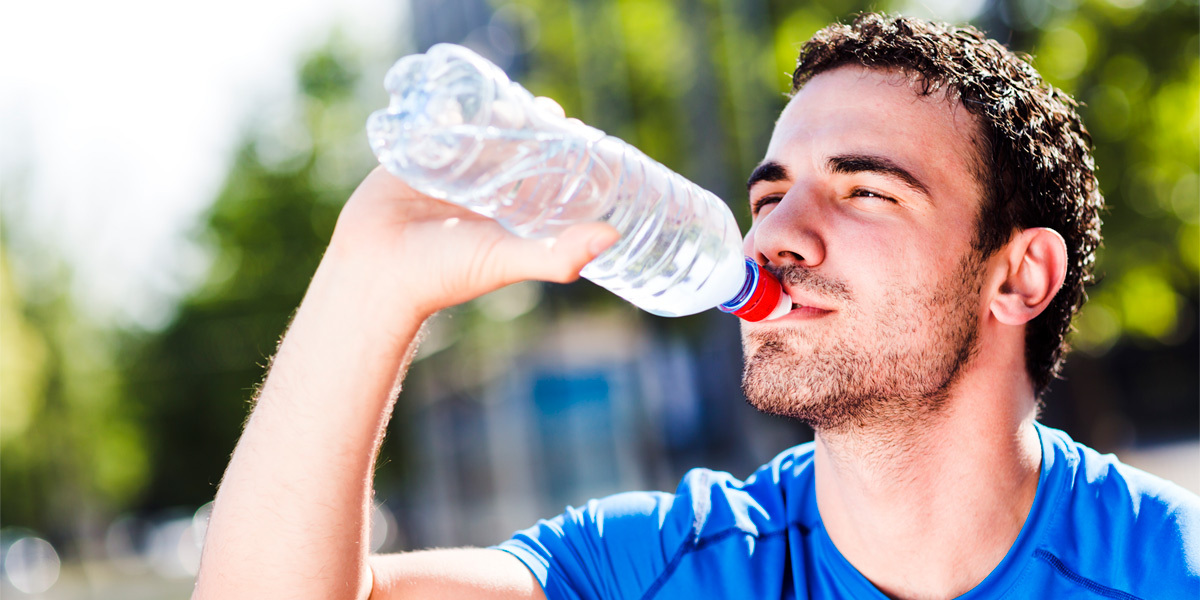

How To Avoid Life-Threatening Health Hazards
The adult human body is about 60 percent water. Without an adequate supply of water, we can experience everything from a dry mouth and insistent thirst to irritability, dizziness, weakness, fainting, muscle cramps, rapid heartbeat, lack of urination and even unconsciousness.
Bad enough for those of us on the ground, dehydration can be especially dangerous for roofers. Add direct sunlight and high temperatures, and conditions are ripe for life-threatening health hazards.

The best way to be safe is simple: Stay hydrated.
Dehydration 101
Job conditions make roofers particularly vulnerable to heat stress and dehydration. Underlayment and shingles can absorb and radiate a lot of heat. Add a roofer’s protective clothing and other gear, and temperatures that are moderate and comfortable on the ground — for instance, 60 to 65 degrees F — can feel like nearly 90 degrees F on the roof.
Hard-working roofers can sweat out more than a quart and a half of water per hour and begin to feel the effects of dehydration after just two hours of moderate work.
What happens inside the body when we get dehydrated? Dehydration makes it harder for the body to thermoregulate — that is, maintain its internal core temperature.
Perhaps the first thing most people notice is the lack of sweat. Sweating releases heat as it evaporates from the skin. When we’re dehydrated, we don’t have enough water to sweat, which means body heat stays trapped and core temperature can rise, leading to heat exhaustion or even heat stroke.
Urine output decreases as the body attempts to hang on to enough moisture to provide adequate blood flow to the heart, muscles and brain. Blood volume also begins to decrease, but the heart still has to pump the same amount through the body to provide cooling and deliver nutrients to the muscles. The reduced volume makes the heart work harder, putting us at greater risk of heat exhaustion.
When blood vessels begin to constrict, we get dehydration headaches. By now, we're finding it harder to do what we need to do, such as nail shingles on a roof. Ordinary tasks take much greater effort because the body is trying to tell us to take a break.
The lower moisture levels affect the brain as well, making us feel forgetful and confused. Symptoms can start at lower levels of dehydration as well — as low as 1.46 percent of body weight for women and 1.59 percent for men.
Remember that decrease in urine output? Observing urine output is the easiest way to tell if we’re dehydrated because it’s one of the few effects we can actually see. If the color is dark yellow, start to worry. If it’s dark brown or reddish, get to a doctor ASAP.
How To Stay Hydrated
The most obvious way to avoid dehydration is to drink fluids. But how much? And what type? The answer isn’t simple.
For people with physically demanding jobs, including roofing, Occupational Safety and Health Administration (OSHA) recommends drinking about 7 ounces every 15 to 20 minutes. The American Heart Association suggests ingesting a pint of water for every pound of sweat you lose. The National Academy of Medicine recommends 3.7 liters (15 cups, or just under a gallon) of total daily fluid intake for the average adult male.
But people have different hydration needs. The level of physical activity plays a role in determining how much you should drink, as do medical conditions such as diabetes or heart disease.
And don‘t think that dehydration is just a hot-weather issue. Dehydration also can exacerbate hypothermia, frostbite and a range of other conditions that can put a crew in danger on the roof.
Better advice is that roofers, like athletes, should drink fluids before they start feeling thirsty — especially since physical activity can dull the ability to determine when we need fluids. Drinking plenty of fluids before, during and after a roofing project can help keep workers from ending up in the emergency room attached to an IV.
More Than Just Water
The best way to stay hydrated, especially when you’re working, is to drink water. It's calorie-free, caffeine-free, inexpensive and readily available. Crushed ice also is a good source, as are tea, juice, sodas and sports drinks — though you might want to keep an eye on the sugar content and calorie counts.
Foods also count toward liquid totals and, in fact, can account for as much as 20 percent of daily intake. Good choices include soups, yogurt, watermelon, salads and oranges.
And yes, you can count coffee as well. Though the Mayo Clinic maintains that caffeinated drinks can trigger headaches and insomnia in some people, most current research indicates that coffee — in moderation — does not lead to dehydration.
Watch For The Warning Signs
Crew members should learn the signs of dehydration and be instructed on how to monitor themselves and fellow workers. Take in fluids as soon as possible to avoid dehydration and heat exhaustion.
Drink water before you work or spend any time outside. And remember that the best way to stay healthy is to understand the science of hydration.









 Gear!
Gear! PRO LOGIN
PRO LOGIN